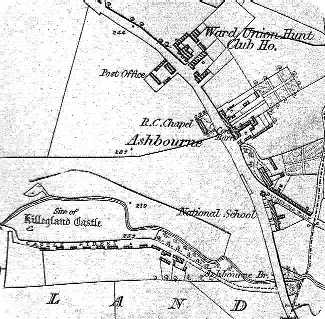
Ashbourne in 1884 Click to enlarge.
Click to enlarge.
Ashbourneis now the second largest town in county Meath. However, it did not exist before 1820. Before then the area was called Killeglan or Killegland.
In 1170, the Normans invaded Ireland, and the entire country was soon subjugated to their rule. They immediately set about carving out the land among themselves. The area then called Meath (Mídh in Irish) was given to a Norman Knight, Hugh de Lacey. Meath had for many hundreds of years been the seat of Irish Celtic royalty. The remains of their ancient forts can be viewed today at Tara.
Hugh de Lacey set about building fortified houses, called mottes and baileys,in case the native Irish would regroup and attack. The remains of a motte and bailey can be found in Ratoath 5 km from Ashbourne.
Once settled, Hugh de Lacey divided the land among his army. A large portion at Killeglan was given to a family called Wafre by 1220. This family lived there until 1420, the last member of this family having built a tower house (a fortified house often called a castle). Ireland is dotted with tower-houses, the nearest to Ashbourne is Dunsoughly Castle 7 km south of the town. It is open to the public by arrangement (see the signs at the gate). The castle and lands became the property of the Segrave family, who remained owners until 1649. They became one of the most influential and wealthy non-aristocratic families in Ireland during the 1500s, with two gaining the high political office of Chancellor of the Exchequer, while another became Sheriff of Meath.
However, their political power and possessions were removed during the religious wars of 1641 to 1650. Indeed, during the Cromwellian period, Oliver Cromwell's son, Henry, stayed for a time in Killeglan Castle. With the final subjugation of the native Irish after 1690, and the imposition of religious persecution in the Penal Laws, a new land-owner named Thomas Carter gained possession of the Killeglan lands. He did not live there, and the castle fell into dis-repair and eventually into ruin. The Carter family held high office in Irish politics during the 1700s but their fortunes waned in the early 1800s. When the Carter estates were sold in the 1840s, the Killegland lands were bought by Frederick Bourne.
Frederick Bourne was a rich entrepreneur who made his fortune from roads and transport. Before 1820 in Ireland roads were almost non-existent. Government regulations allowed for considerable spending on roads, and the subsequent improvements ensured greater post-coach services. Bourne owned a coach company and financed road-building, collecting revenue from tolls. He financed a ten mile (old Irish miles) section of road from Dublin to Killegland. He decided to build a small town with an inn, a hotel and other small businesses (see enlarged map of 1883) to make money from travellers. He built this village near his ten mile tollbooth and named the place after his favourite tree, and himself, i.e. Ash and Bourne. This began in 1820.

The Hunter's Moon. One of the first pubs in Ashbourne
Bourne's idea was a great success. However, by 1850 rail was taking business from the roadways, and the Bourne family fortune declined. In 1821 the population was 133, by 1841 it was 411. Unfortunately the Irish famine took its toll from 1845 to 1851, and the population declined. Frederick Bourne left his land at Killegland, and his village of Ashbourne, to his son Richard in 1844. Richard lived in the village, and his first home is now the Ashbourne House Hotel on Frederick Street. Later he built a modest house down Castle Street near where the last remains of the Wafre and Segrave tower house were. Richard married the daughter of a wealthy local family, Elizabeth Mangan, and had several children. The eldest, Thomas, became his father's heir and the last landlord of Ashbourne. He left Ireland and went to live in Northfleet, Kent, England in 1899. The land was sold to the local tenants.
Ashbourne was a small village with a population under 400 until 1970. Then, in response to the growing population of nearby Dublin, a new scheme of houses was built in Ashbourne, based on the American open plan scheme rather than with fenced-off gardens. This was new in Ireland. From then to now Ashbourne has grown to a population in excess of 5,000 with more housing schemes underway and in the planning stages.